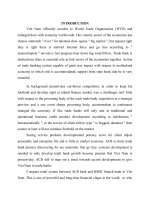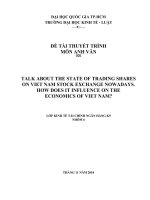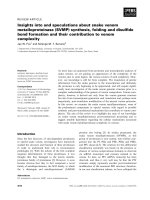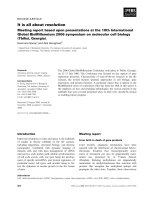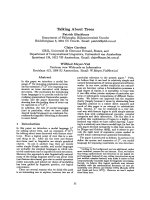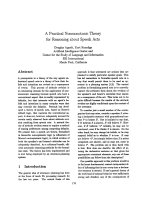about starbucks
Bạn đang xem bản rút gọn của tài liệu. Xem và tải ngay bản đầy đủ của tài liệu tại đây (2.17 MB, 15 trang )
<span class="text_page_counter">Trang 2</span><div class="page_container" data-page="2">
<b>I. </b>
Technology has led the way, enabling supply chain software to become faster and more efficient. With technology, through warehouse and transport systems, businesses are able to provide data-capture, improve labour management, monitor resources and reduce stock losses with real time stock checking.
Starbucks, the largest coffee chain in the world with more than 30,000 locations over 70 countries, is an example of how technology keeps a business stay ahead of the competition.
<b>II. Company Information: 1. About Starbucks </b>
Starbucks Corporation was founded by Gordon Bowker, Jerry Baldwin and Zev Siegl in 1971, the first store was opened in Pike Place Market in Seattle. In 1982, Howard Schultz joined Starbucks as director of retail operations and marketing. Starbucks begins providing coffee to fine restaurants and espresso bars. After 5 years, Schultz purchased Starbucks and brought the Italian coffee house culture to Seattle, his vision was to develop Starbucks to a national coffee chain from a tiny regional operation and then a multinational brand. At the present, Starbucks has become a coffee empire worth 82 billion USD with several milestones and awards. For many years, Starbucks has won the award of Best Company Happiness, Best Company For Women, Best Company Work-Life Balance because thanks to its contribution for staff and social. In 2019, Starbucks marked the global milestone with its 30,000th store. (Starbucks, 2019)
For Starbucks, one of the keys to the brand’s success is the supply chain. The international coffee giant has widely studied and acclaimed supply chain management practices, which, according to some, make Starbucks’ coffee and customer experience superior to those of its competitors. (Supply Chain Putting the Star in Starbucks, 2017)
So, what exactly is Starbucks doing differently than other international coffee retailers? Is its coffee truly better?
<b>2. Starbucks Supply Chain </b>
<b>a. Core values: </b>
</div><span class="text_page_counter">Trang 3</span><div class="page_container" data-page="3">- Creating a culture of warmth and belonging, where everyone is welcome. - Acting with courage, challenging the status quo.
- Being present, connecting with transparency, dignity and respect.
- Delivering our very best in all we do, holding ourselves accountable for results. - We are performance driven, through the lens of humanity. (R.Satterfield, 2015)
b. Missions: to inspire and nurture the human spirit one person, one cup and one –neighborhood at a time. (Mission Statement | Starbucks Coffee Company, n.d.)
<b>c. Starbucks’ Supply Chain Model: </b>
<b>• Suppliers: </b>
Each region in the world can grow coffee with different flavor: In Latin America, coffee has the acidity and aroma of cocoa beans; In Africa, the seeds are succulent, with aromas of flowers, lemons and strawberries; In Asia-Pacific, coffee is bold, smooth, with a grassy and rustic scent. Due to that differences, Starbucks purchases coffee directly from the farmers of four coffee growing regions around the world: John Parry's coffee in Hawaii, smallholder coffee farmers in the Lintong district of Sumatra, coffee of a small village in Aricha district Yirgacheffe in Ethiopia and the Baumann family coffee in Mexico. These are all coffees with a very unique taste that is not available anywhere in the world, which has contributed to the success of Starbucks.
In addition, Starbucks also has companies that provide modern equipment and systems, as well as companies that manufacture coffee packages and cups. In supplier relationships, Starbucks treat them with respect and ethics, providing the best conditions for Starbucks partners to operate effectively.
<b>• Manufacturing Factories </b>
Some manufacturing factories are set up by Starbucks to serve the needs of the company. With the remaining needs, they cooperate with other factories. The following are Starbucks’
</div><span class="text_page_counter">Trang 4</span><div class="page_container" data-page="4">- Kent factory in Kent, Washington. Kent is a flexible factory and the only factory that has three continuous production processes: roast Starbucks coffee and the best of Seattle coffees, blend Tazo tea and versatile instant coffee to Starbucks VIA coffee ready to brew. Built in 1992, Kent is the oldest factory of Starbucks.
- Carson Valley coffee roasting factory in Minden, Nevada. Carson Valley roasting factory is one of the largest coffee processing factory in the world.
- Bay Bread Bakery Factory in South San Francisco, California. "Shaw" is the nickname of the street where this factory is located on, but it is officially known as the Bay of Bread. It is the largest plant with three functions: Prepare products for La Boulange stores, prepare products for Starbucks stores, test and develop new products. - New French Bakery factory in Ventura, California. This is the factory focuses only on
the wholesale department.
- Evolution Juicery Factory in Rancho Cucamonga, California is a sizable fruit juicer that provides Starbucks with the characteristic flavors in their coffee.
- York coffee roasting factory in York, Pennsylvania. This is one of the largest coffee processing factories in the world and the largest distribution center for Starbucks. It supplies products to Starbucks and domestic and international grocery stores. - Sandy Run factory in Gaston, South Carolina. Sandy Run is a highly automated coffee
roasting plant. Launched in 2008, Sandy produces more than 1.5 million pounds of coffee every week. The factory received the LEED gold certification.
<b>• Distributors </b>
Starbucks created a system of coffee shops by itself to introduce and sell products. Starbucks’ stores system are distributed throughout the world. In addition to creating its own Starbucks stores, it also franchises its business to many companies around the world. The company also plans to open hundreds more stores in Vietnam in the coming years and more than 3,000 stores in North America in the next 5 years. It can be said that Starbucks' product distribution system is very large and they have a very reasonable market expansion strategy to sell their products.
<b>• Customers </b>
</div><span class="text_page_counter">Trang 5</span><div class="page_container" data-page="5">preferences and needs. Starbucks wants to provide unique customer experiences by connecting with them in a culturally appropriate way.
Starbucks uses different channels to distribute its products outside the company-operated stores. These include arrangements with food service companies, licensed partners, grocery channel, warehouse club accounts, direct- -customer market channels, joint ventures and other tospecialty operations. This means the company utilizes more than one distribution design. Firstly Starbucks sells its products through a direct retail system in company-owned stores. They import and process coffee and then sell it under their own brand name in their own stores. However, Starbucks also sells its products in supermarkets and shopping centers. Additionally Starbucks has distribution agreements with office coffee suppliers, hotels, and airlines. Using multiple distribution channels allows the company to reach a wider market, however, while doing so Starbucks needs to careful with this approach due to the potential for channel conflict. (Starbucks’ Distribution Channel, 2012)
<b>d. How it works: </b>
- Works under a direct model.
- R&D (innovation - creation - development)
- Production for inventory (BTS)
- Use Just in time (JIT) method
(Bài học kinh doanh và chuỗi cung ứng của Starbucks - VILAS, n.d.)
<b>e. Highlights </b>
<b>• Using 3PLs service </b>
Starbucks uses 48 CDCs (Main Distribution Center) as in the US, seven in Asia - Pacific, five
</div><span class="text_page_counter">Trang 6</span><div class="page_container" data-page="6">other commodities so regular deliveries are routed through dedicated truck fleets for Starbucks own retail and retail stores that sell Starbucks-branded products.
<b>• Sustainable inbound logistics </b>
- Traders selected by the company select the best quality coffee beans from producers in Latin America, Africa and Asia.
- Unripe or unroasted beans are purchased directly from farmers by designated Starbucks dealers.
- The beans are then transported to a storage area where they are roasted and packaged - They are ready to be shipped to DCs, which are very few owned by the company, most
run by 3PLs.
- The company does not outsource purchasing activities to ensure high quality standards of coffee beans from the moment of selecting coffee beans at source.
<b>• No intermediaries in the output logistics </b>
There is very little middleman presence in selling products because "The vast majority of Starbucks products are sold in their own owned stores or only in licensed stores."
</div><span class="text_page_counter">Trang 7</span><div class="page_container" data-page="7"><b>III. </b>
Back in the early 2000s, Starbucks’ business was starting to gain momentum but their supply chain and logistics teams were struggling to keep up. The famous coffee business quickly realized that they needed to put strategies and technologies in place to master the movement of their ingredients, materials and products. For the context of this paper, the authors will only discuss some highlighted, not all, technological aspects from Starbucks supply chain.
<b>1. Manufacturing: </b>
Starbucks does not just sell a steamy cup of coffee, it is likely customers have also encountered some packages of instant coffee on its shelves. Often, other instant coffees lacked flavor or were bitter, and it seemed like they never dissolved completely. But all that has changed with Starbucks’ latest soluble coffees—like its VIA Ready Brew brand—made in a new, modern plant with sophisticated continuous process controls and packaging.
Starbucks management thought that with the right tools, the company could make a soluble coffee that would change the way consumers feel about instants and compete successfully in the soluble coffee market segment, especially if it could replicate the flavor of coffee freshly brewed in its stores.
By designing, building and operating the Georgia- based facility from top to bottom, Starbucks could tap into new technologies to create a more efficient, automated process. Starbucks set out to create a facility with a proprietary design, not a single outside vendor’s off-the-shelf system. (Labs, 2015)
<b>2. Distribution: </b>
Management has made significant short and mid-term investments in digital technologies to reduce waste and limit inefficiency in their supply chain in recent years. One such example is their adoption of an automated information system combined with a centralized logistics planning network. This allows real-time monitoring of demand down to the store-level, as well as up- -to
</div><span class="text_page_counter">Trang 8</span><div class="page_container" data-page="8">Operations Management, 2017)
Other applications of technology in the distribution system that consumers are more aware of are the My Starbucks Rewards Program and Mobile Order & Pay system. While these are certainly marketing and operations-driven initiatives, the data collection with these systems for regional and seasonal demand fluctuations in product mix related to customization further enhances the responsive capabilities of their digital supply chain systems.
Starbucks is planning to Adopt RFID Technology. In the early days of February 2020, McDonald’s and Starbucks introduced the idea of pilot programs. This program’s purpose was to deploy test systems for collecting, cleaning, and redistributing plastic coffee cups. It means that you could get a coffee cup you used a few months ago in the coming years when you order coffee from McDonald’s and Starbucks. There were two winning proposals, one being a UK-based start-up known as CupClub in which coffee drinkers scan an RFID tag at drop off and pick up location. After the scanning procedure, all the cups will be stacked up and sent for the cleaning process. Coffee cups, integrated with RFID tags, can be tracked at various shop counters and nearby collection sites. (McDonald’s and Starbucks are Planning to Adopt RFID Technology - RFID Card ™, n.d.)
<b>3. Retail location (Starbucks Shop): </b>
The company said it plans to double the number of $11,000 Clover coffee brewers in stores. The machines can connect to the cloud through a system called CloverNet, track customer preferences, update recipes digitally and self-monitor performance so problems can be flagged up.
It isn't just coffee makers that are being given a makeover. The coffee giant is also considering connected fridges that monitor ingredients -- for example, technology which informs baristas when milk has spoiled. (Osborne, 2013)
<b>4. Customers: </b>
Starbucks has been using reinforcement learning technology — a type of machine learning in
</div><span class="text_page_counter">Trang 9</span><div class="page_container" data-page="9">external feedback — to provide a more personalized experience for customers who use the Starbucks mobile app. (Sokolowsky, 2019)
<b>5. Logistics: </b>
Millennial consumers have increasingly become more interested in knowing where their food comes from, how it was grown and whether it was produced in a sustainable and ethical way. Starbucks is working with Microsoft to develop a block chain-based supply chain tracking system and mobile app that will allow customers to track the supply chain journey of the beans they buy and the coffee they drink. Starbucks Corp. fans can now trace their coffee. And so can farmers, who will know for the first time where their beans end up. The firm hopes the technology will provide real time information about the beans within the supply chain and help financially empower rural farmers. This is called the Starbucks Digital Traceability program. (Warnick, 2020)
<b>IV. How Covid-19 disrupted Starbucks and Coffee Industry 1. Coffee Industry </b>
The corona-virus crisis has caused sales volumes to decrease by 50% in Europe and an estimated 25% in the United States (Kruft, n.d.) . Roasters are ordering less coffee from importers, and warehouses are pretty full. Many coffee bars and roasters in Europe are using government subsidies to pay their employees’ salaries that the period of lockdown and social distancing measures have caused a reduction in consumption.
When the worst of the corona-virus crisis is over, for example, in one year, with businesses operating and possibly still with some form of social distancing, the small coffee businesses will recover. However, they will only recover as much as restaurants and coffee bars can return to receiving their original number of customers. Virologists agree that even with a vaccine against the current COVID-19 virus, there is still the threat of new viruses or mutated forms of the current one.
<b>2. Starbucks </b>
For the beginning period of a pandemic outbreak. Global Coffee Chain as Starbuck was tackled with the lockdown from governments, it is affecting the coffee flow, and there is a shortage of
</div><span class="text_page_counter">Trang 10</span><div class="page_container" data-page="10">period.
Flights are more heavily affected. For example, there are big capacity problems to and from Latin America, Africa, Guatemala, Laguna . Export to China and Asia is at a lower level, as well as import from Africa. That might affect timely shipping. Courier services are suffering more noticeably, with documents and samples arriving later than normal.
<b>a. Inbound Logistic </b>
Starbucks sources its coffee beans directly from nearly 30,000 coffee farms around the world, in countries such as Brazil, Columbia, Guatemala, Kenya, Mexico, Saudi Arabia, and Tanzania. Starbucks suppliers are carefully selected by following Starbucks’ own Coffee and Farmer Equity (CAFE) standards and Coffee Sourcing Guidelines (CSG) (Gruley, 2014) . Each Starbucks supplier needs to meet these standards and requirements. According to Starbucks, the farms must have safe working conditions and not use forced or child labor. All of these coffee bean suppliers will pour directly to Roasting and Packaging Plants in China and America. Covid-19 has disrupted this international chain that caused the overloaded warehouse management in America and transportation limitations.
Thanks to long-term relationships with suppliers are an important key that helps Starbucks overcome the crisis safe and sound. They have time to reorganize the supply chain and improve processes. Shifting to contact-free selling and drive-thru service have brought stunning results for Starbucks.
<b>b. Operation </b>
Starbucks distribution strategy is really impressive before pandemic. Starbucks stores are spread over six continents, so the company has six central storage facilities that make it possible to streamline the logistics across 32,000 stores in 69 countries . (Number of Starbucks Worldwide 2021/2022: Facts, Statistics, and Trends - Financesonline.com, 2021)
After arriving at a storage facility, raw beans are roasted right there, thus ensuring the same
</div>